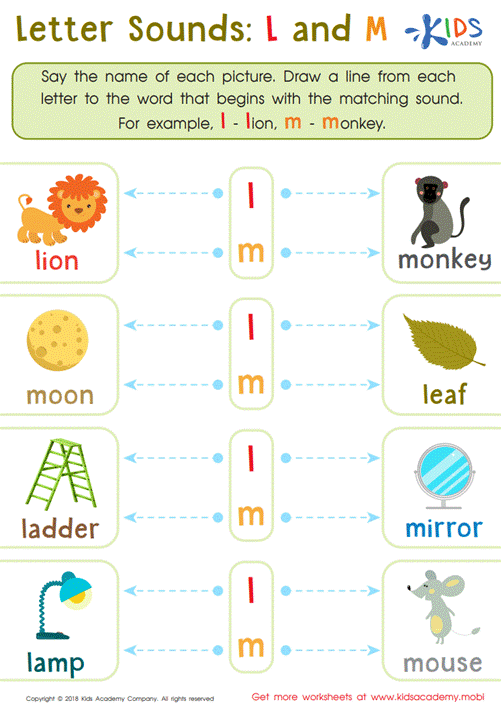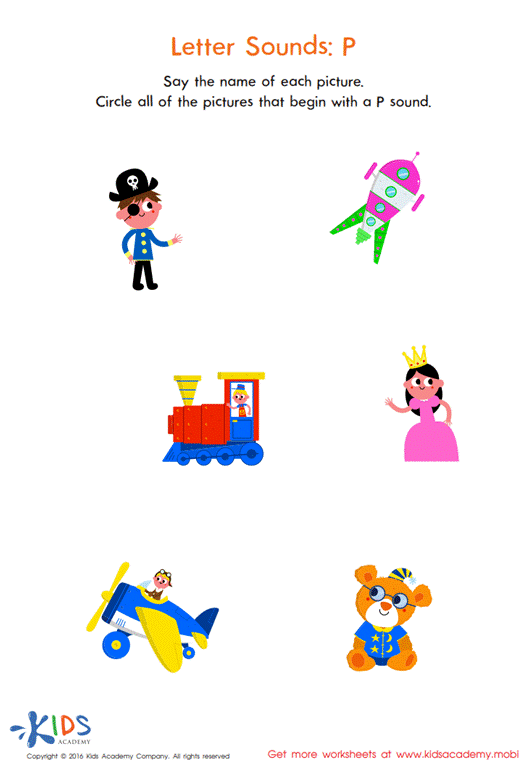-
English
-
English Pre-K
-
Unit 1: Early Literacy Skills
-
ABCs
- Pre-writing Activities
- Letter A
- Letter B
- Letter C
- Letter D
- Letter E
- Letter F
- Letter G
- Letter H
- Letter I
- Letter J
- Letter K
- Letter L
- Letter M
- Letter N
- Letter O
- Letter P
- Letter Q
- Letter R
- Letter S
- Letter T
- Letter U
- Letter V
- Letter W
- Letter X
- Letter Y
- Letter Z
-
Phonological Awareness
- Rhyming Words
- Letter Sounds B, C, D, and F
- Letter Sounds G, H, J, and K
- Letter Sounds L, M, N, and P
- Letter Sounds Q, R, S, and T
- Letter Sounds V, W, X, Y, and Z
- Letter Sounds A, E, and I
- Letter Sounds O and U
- Beginning Sounds
- Matching Letters to Sounds
-
ABCs
-
Unit 2: Vocabulary
-
Common Words
- Sorting Words into Categories
- Color Words
- Verbs and Adjectives
-
Sight Words
- Sight Words 'I' and 'Can'
- Sight Words 'You' and 'Like'
-
Common Words
-
Unit 3: Print Awareness
-
Parts of a Book
- Working with a Book
- Spaces Between Words
- Text and Illustrations
-
Picture Books and Poems
- Picture Book Text Features
- Poem Text Features
- Signs and Labels in the Community
-
Parts of a Book
-
Unit 4: Reading Literature
- Questions About Stories
- Discussing Stories
-
Unit 5: Reading Informational Texts
- Retelling Details in a Text
- Questions About a Text
- Connections Between Events
- Text Features
- Describing Illustrations
-
Unit 1: Early Literacy Skills
-
English Pre-K
-
Math
-
Math for Pre-Kindergarten
-
Logic and Geometry
-
Matching and Sorting
- Same and Different
- Which One Is a Little Different?
- Objects That Go Together
- Sorting by Color and Size
- Sorting The Same Group in Different Ways
- Patterns
-
Shapes
- Shapes in Our Environment
- Naming Shapes Regardless of Size
- Making Shapes in Preschool
- Comparing Shapes
- Relative Positions
- Sorting Shapes
-
Matching and Sorting
-
Early Number Sense
-
Numbers 1–5
- Counting to 3
- Counting to 5
- Arranging Objects up to 3 Objects
- Arranging up to 5 Objects
- Writing Numbers 1–5
-
Numbers 1–5
-
Numbers up to 10
- Counting to 10
- Arranging up to 10 Objects
- Number 0
- Writing Numbers 6–10
- Breaking Down Numbers 6-10
-
Logic and Geometry
-
Math for Pre-Kindergarten
Letter Sounds L, M, N, and P
Teaching your preschooler the sound each letter makes is an important part of the language learning process. It lays the foundation for later reading and writing skills. One aspect of this foundation is phonological awareness. Phonological awareness is a skill children learn at the preschool stage. It consists mainly of the ability to recognize, segment, blend and manipulate sounds. For example, when a child shows the ability to identify the first letter of a word you said, it means their phonological awareness skills are developing. In this article, you'll find a simple guide on how to teach your child the letter sounds L, M, N, and P through easy and fun activities.
Letter Sound L
The letter L makes a /l/ sound, as in the word lamp. To help your child practice this letter sound, play a clapping game. To play the game, you will need to say random words, some containing one /l/ sound, some containing two, and some without it. Have your child listen to the words carefully and clap once if the sound occurs one time, clap twice if it occurs two time, and if it doesn’t occur they don’t clap.
If your child is enjoying the activities, you can also use this one to teach them the letter sound L. Print out some images, ensuring you include the images of a lion, lettuce, lunchbox, lips, and leaf. On a paper, draw a big letter L on the top, and have your child name the images as they glue the ones that start with an L on the paper.
Letter Sound M
The letter M produces the sound used to pronounce one of the words most used by children: Mom. One way to help your child practice the letter sound M is by trying to find words that start with it. Take turns naming objects that start with a /m/ sound. If they are having trouble finding a word, give them a hint to help them. For instance, if they take a long time without finding a word, you can say "Hmmm, can you remember something that starts with an M that is white and you can drink warm?" to help them guess milk.
In addition, this “Letter Sounds: L and M” worksheet from Kids Academy is a great way for your child to work on differentiating the most recent sounds they came to learn. In this worksheet, they will name a familiar picture and match it to its corresponding beginning sound. Encourage your child to listen closely as they say each word. Does it start with the letter L or M?
Letter Sound N
The letter N makes the sound /n/. Prepare this activity for your child to help them practice identifying the letter N sound. Print out a paper with a set of colorful images of familiar objects, half of which start with the letter N, and half with other random letters. Using safe scissors, help them cut the images, then identify the name of each image. On a piece of paper, ask them to create a collage with the images that start with the /n/ sound.
You can also integrate a balls and basket activity, where your child will have to find balls with images that start with an N glued on them, such as nail, nose, necklace, etc., and put them in their corresponding basket, while putting other balls with objects that start with letters other than N in the other basket.
Letter Sound P
The sound /p/ corresponds to the letter P. It is used in words like please, happy, and jump. To encourage your child to think more about the playful letter P, play a game you can call “Parrot Talk”. In this game you will say words, and your child should only repeat the ones that start with a P.
Another activity to practice the letter-sound P is to print out this Kids Academy “Letter Sound: P” worksheet. This worksheet will provide your child with the chance to practice simple phonics skills as they prepare to read. The fun illustrations will motivate your young learner as they identify the beginning sound of each word!
Now that they have learned and practiced the sounds of the above letters, you can offer them one activity that addresses all the four letter sounds at once. For example, you can play a variation of the hopscotch game. On four papers, draw big bubble letters L, m, N and P, and arrange them on the floor in a T-shaped format. Have your child throw a rock or any other object so that it lands on one of the papers. Your child should then hop on one leg to the paper where the object landed, and say a word that starts with the letter sound they hopped on. When you're done with this activity, your child will be ready to move on to the next bundle of letter sounds: Q, R, S, and T.
Check out our interactive catalogue for more articles on preschool language studies.


